Working with stakeholders
Roles and responsibilities
- The right skills and abilities to fill the role
- Who is available?
- What motivates them?
Pre-assignment, the sponsor assigns team members to your project.
Many people avoid discussing their differences, but if you encourage those conversations, you will find a richer understanding and greater creativity that comes from people working together across identity differences. To do this effectively, it is important to dedicate time early on in the team building process to develop trust between team members.
Team size, skills, availability, and motivation are the building blocks to creating your very own dream team. Always keep in mind that a project manager does not just select dream teams, they create dream teams through collaboration under great leadership.
Roles
Stakeholders
- Primary - directly affected by the outcome of the project.
- Secondary - indirectly affected by the outcome of the project.
Sponsors, another primary stakeholder, VIP, critical to communicate with, CEO could also be the project sponsor.
Team mambers, considered primary stakeholders.
User, considered primary stakeholders.
Project Manager, considered primary stakeholders.
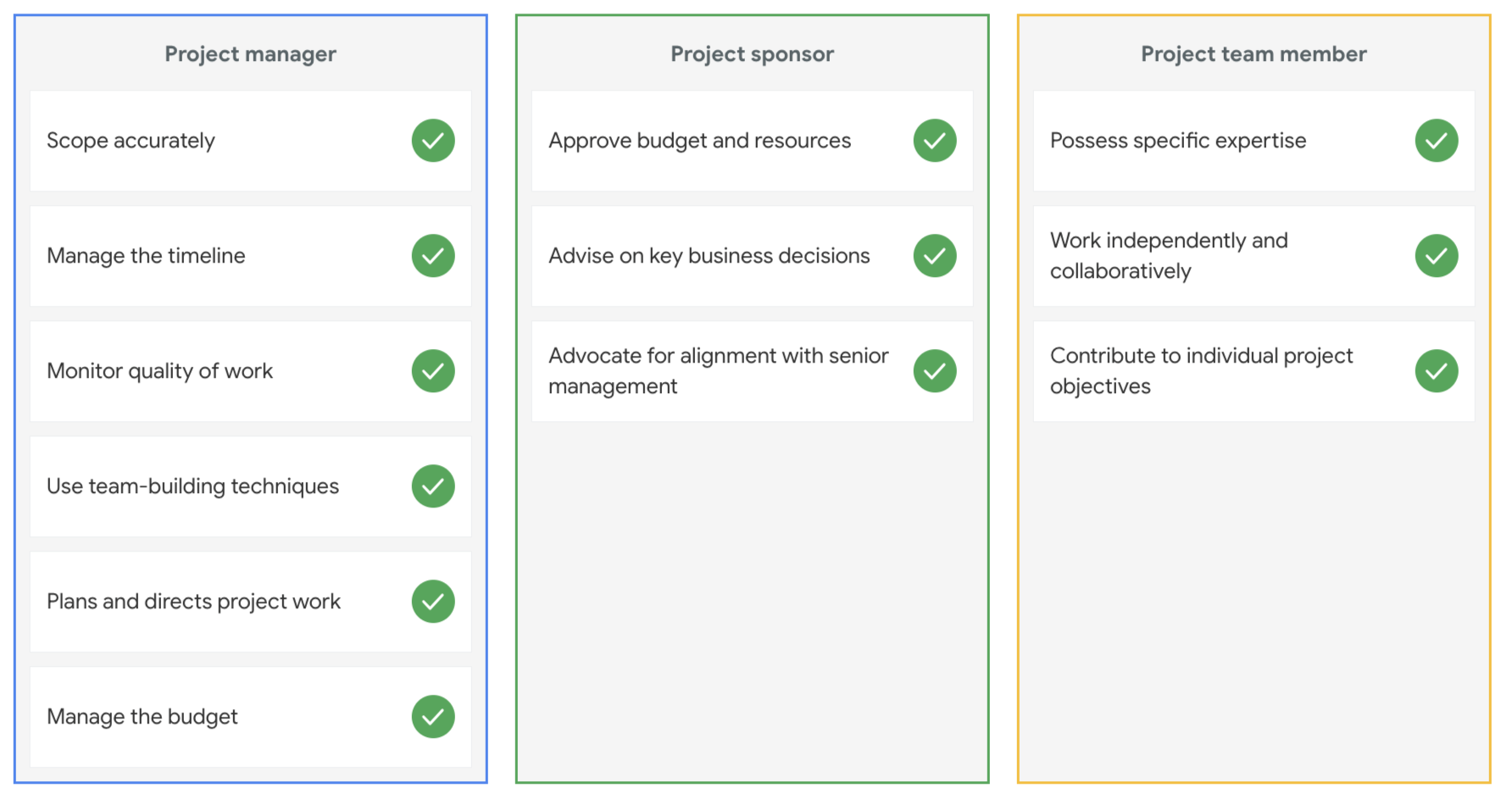
Evaluating stakeholders
Questions for stakeholders:
- What are your most important priorities/goals?
- How will this initiative/project support you and your most important priorities?
- What role would you like to play within this initiative/project?
- Here's how I plan to keep people informed; does that work for you?
- What can I clarify for you?
- What are your expectations? What would you like for the project to accomplish?
- What would success look like for you?
- Who else do you recommend I reach out to about this initiative?
- What information or insights do you have that might be challenging for me to find?
- Where do you see me getting support for this initiative? Facing resistance?
Stakeholder Analysis
Ref.: Stakeholder-analysis-and-power-grid
Make a list of all the stakeholders the project impacts.
- Who is invested in the project?
- Who is impacted by this project?
- Who contributes to this project?
Determine the level of interest and influence for each stakeholder—this step helps you determine who your key stakeholders are. Factors that will play a role in determining a stakeholder's ability to participate in a project, like physical distance from the project and their existing workload. Various types of stakeholders—some will be active stakeholders with more opinions and touchpoints and others will be passive stakeholders
You might want to form a steering committee during some projects. A steering committee is a collection of key stakeholders who have a high level of power and interest in a project. A steering committee can influence multiple departments within the organization, which means that they have the potential to release a greater number of resources to the project manager.
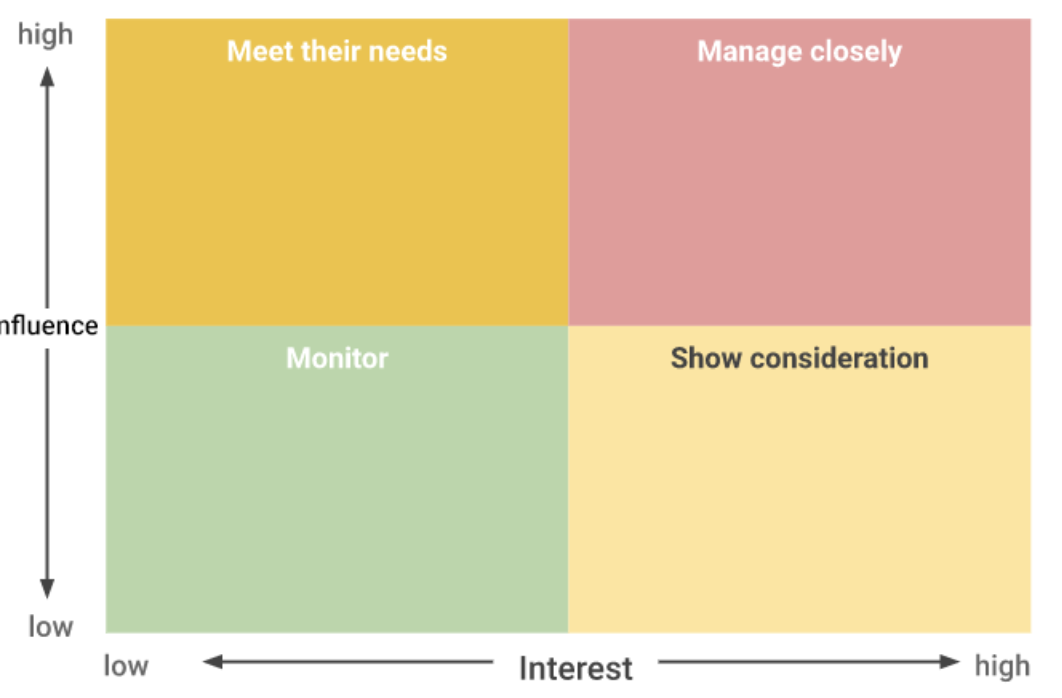
Example
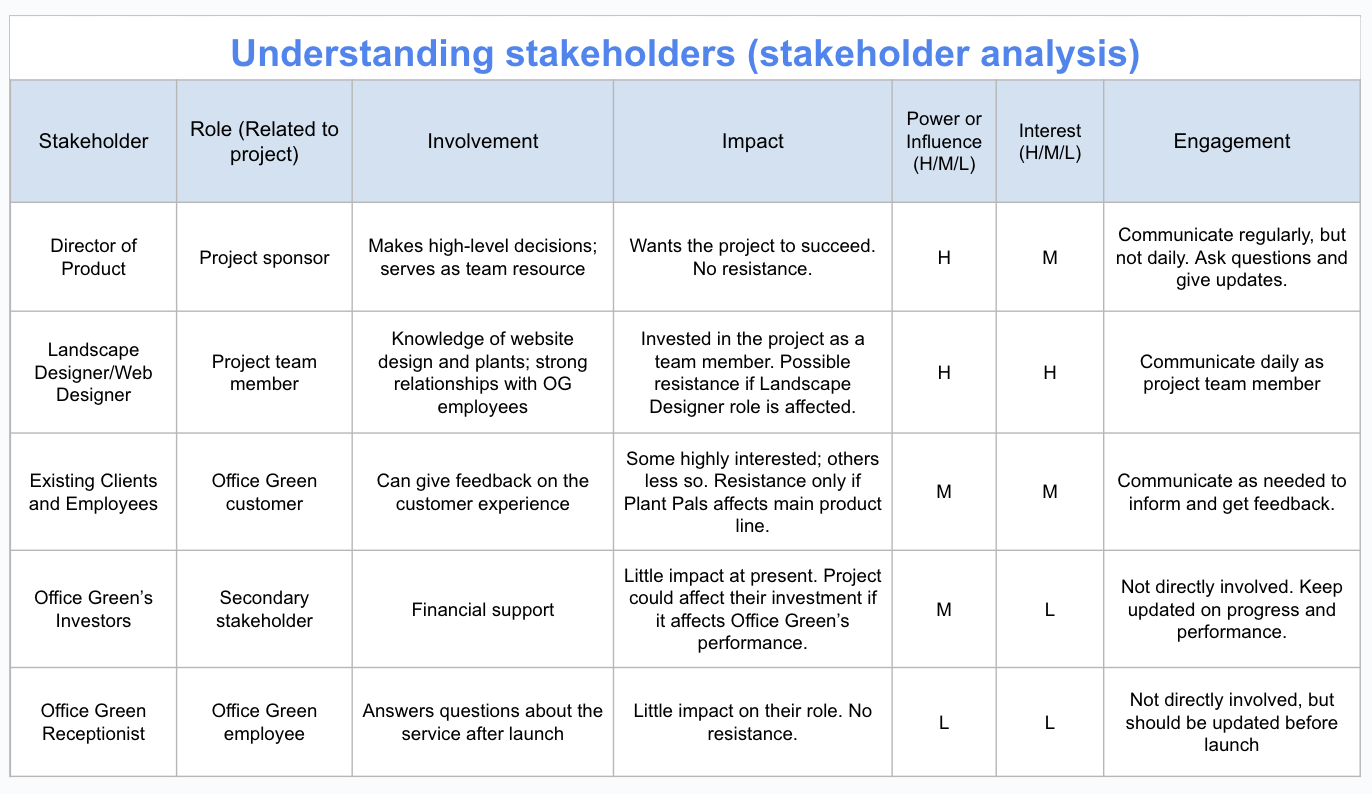
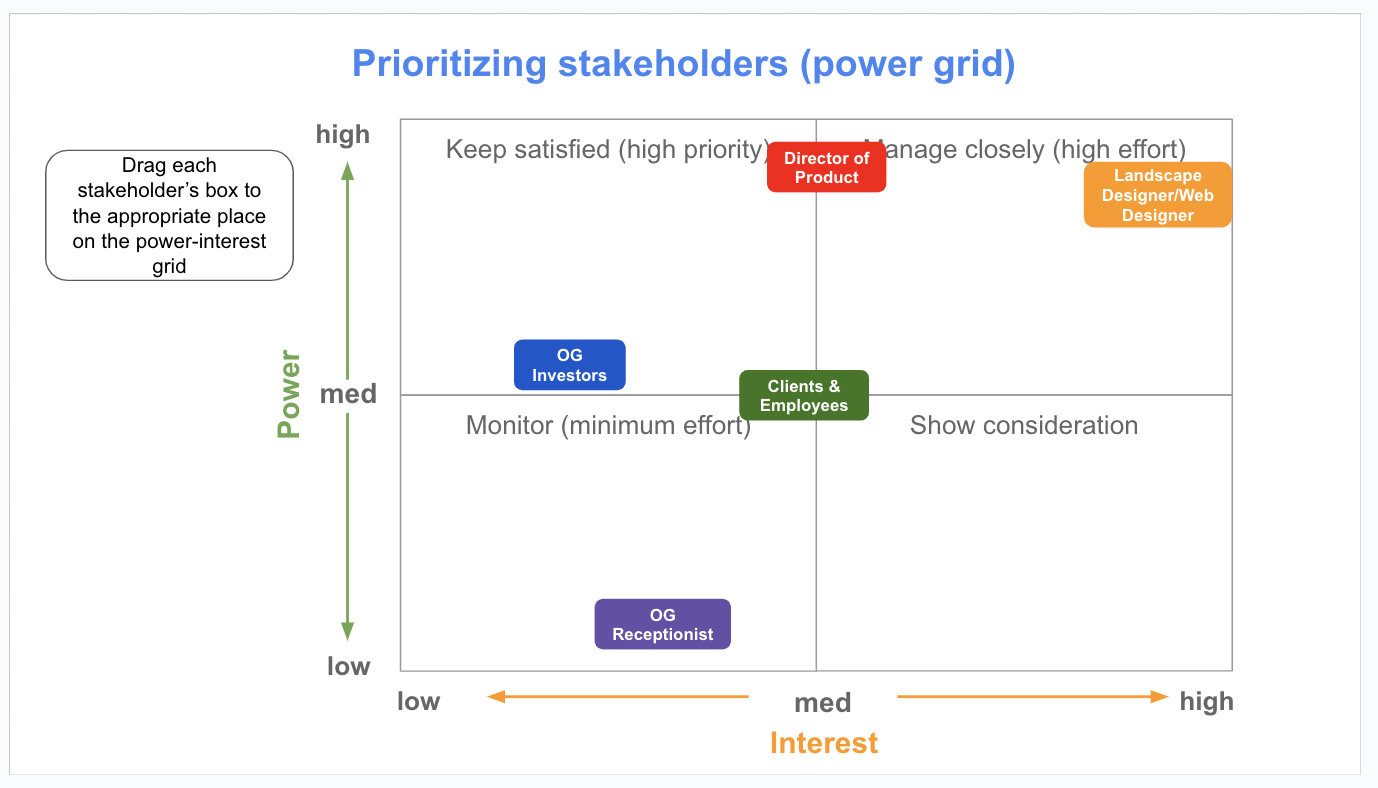
Prioritizing stakeholders and generating their buy-in
- Clearly mapping the work of the project to the goals of the stakeholder.
- Describing how the project aligns with the goals of the stakeholder's department or team.
- Listening to feedback from the stakeholder and finding ways to incorporate their feedback into the project's charter where appropriate.
RACI Chart
Ref.: Template_-RACI-chart—Phase-1
Often referred to as a Responsibility Assignment Matrix (RAM), RACI diagram, or RACI matrix.
Use it to get an overview over workload balance and avoid silos, where the knowledge and responsibility for a task falls on one person.
You can document your team and stakeholders' acknowledgment of these expectations through the project charter, meeting notes, and in the RACI chart itself.
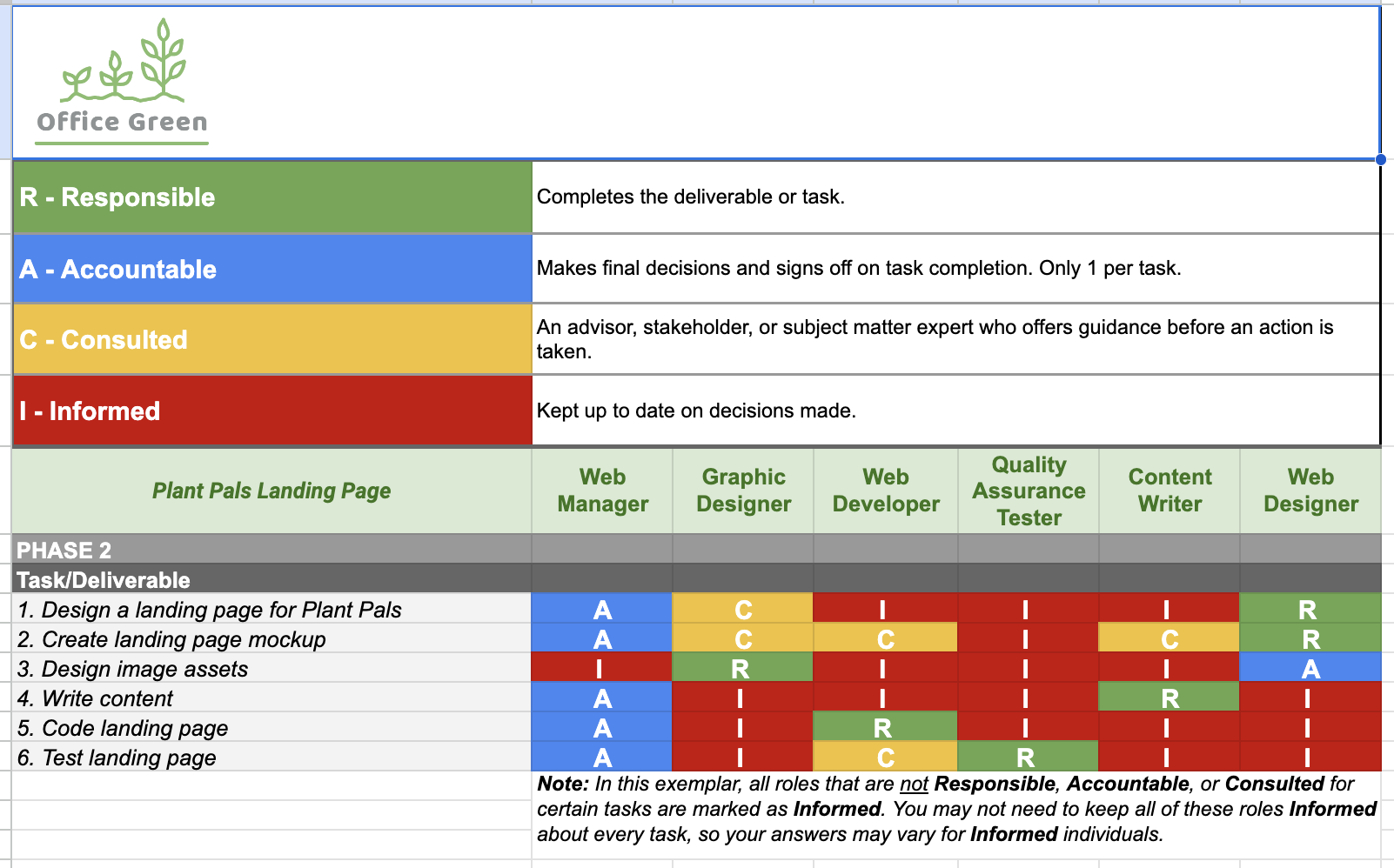
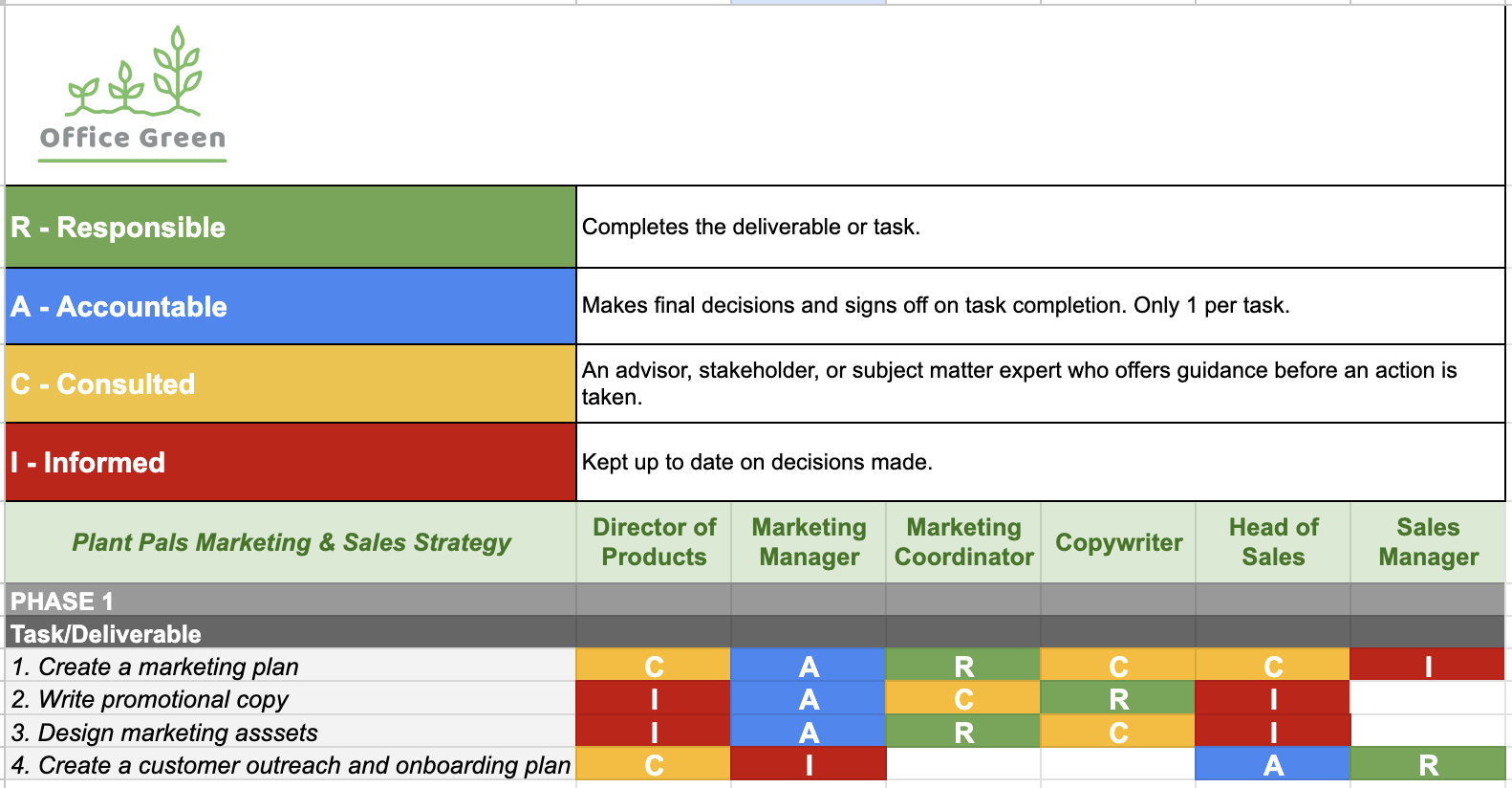
A RACI chart creates clear roles and gives direction to each team member and stakeholder.
- R: Responsible: who gets the work done
- A: Accountable: who makes sure the work is done
- C: Consulted: who gives input or feedback on work
- I: Informed: who needs to know the outcome
Where possible, it is helpful to separate these roles.
Types
1. Responsible
The ones who are actually doing the work.
- What department does the work fall under?
- Who will perform the work?
2. Accountable Making sure the task gets done. It is important to have only one individual accountable for each task.
- Who will delegate the task to be completed?
- Who will review the work to determine if the task is complete?
3. Consulted Have useful information to help complete the task. There is no maximum or minimum number of people who can be assigned a "consulted" role.
- Who will the task impact?
- Who will have input or feedback for the responsible person to help the work be completed?
- Who are the subject matter experts (SMEs) for the task?
4. Informed Need to know the final decisions that were made and when a task is completed.
- Who cares about this task's completion?
- Who will be affected by the outcome?
Put your RACI into practice
Share your RACI chart with your sponsors and stakeholders to get buy-in and sign-off. When you get stakeholder buy-in, you will be able to set clear expectations for your team and ensure that everyone is aligned on their responsibilities.
Stakeholder management during project initiation
-
Identify all the stakeholders at the beginning of your project or initiative. Get everyone involved as early as possible to set clear expectations, responsibilities, and boundaries. Identifying your stakeholders early on gives them ample time to voice any concerns they may have about the project or their role within it. If they feel a sense of ownership from the beginning, your stakeholders may be more likely to embrace their roles, give appropriate input, and help remove barriers to allow the project to move forward.
-
Keep the project vision clear. The project vision describes the need the project is fulfilling. It is important to have a clear, specific project vision because, as we have learned, stakeholders may apply pressure to increase the requirements, shorten the timeline, or cut resources. Ensuring that stakeholders have agreed upon the vision—and, more specifically, what "done" looks like—provides clarity for everyone involved with the project. Including highly-influential stakeholders in the strategic planning processes will make sure that all team members are aligned with project vision.
-
Equip your stakeholders with user-friendly resources at all times. This could mean creating a one-pager (a one-page document that provides an overview of your project) or weekly status report with the latest information and links to the main project artifacts. It may also mean ensuring everyone has access to necessary documentation.
Stakeholder management throughout the project life cycle
You will have to maintain good relationships with all of your stakeholders to ensure they are satisfied and contributing to the team. The following strategies can help you get to know your stakeholders' interests, concerns, and communication preferences and enlist their help throughout your project's life cycle:
-
Find out what stakeholders care about and why. Ask your stakeholders: What are your most important priorities and goals? What role would you like to play in this project? How will this project support you and your most important priorities?
-
Adjust your communication frequency and approach based on stakeholder roles and preferences. Tell your stakeholders: Here's how I plan to keep you informed—does that work for you?
-
Enlist the help of senior stakeholders when necessary. Ask your stakeholders: Who else do you recommend I reach out to regarding this project?
-
Once stakeholders have a vested interest, bring project problems to them. Ask your stakeholders: How would you handle this situation? What solutions come to mind?
Tips for navigating scope with stakeholders
Understand motivations. Before your discussion, consider each stakeholder's motivations for wanting to adjust the project's scope. Some of those motivations are budgetary (such as wanting to reduce the project's costs), some are interpersonal (such as wanting more time to complete tasks), and some are related to personal career goals (such as maintaining their current position or striving for a promotion). Understanding your stakeholders' motivations can help you work together to find a compromise.
-
Set the scene. Start the discussion with a reflection on why you are meeting. Remind your stakeholders why you are engaged in this project, and assure them that you all share a common goal.
-
Listen first. Hear what your stakeholders have to say before you present your views. This will demonstrate your desire to understand the other party's perspective. Acknowledging their point of view may make it easier for them to accept your suggestions or solutions when their ideas or opinions differ from yours.
-
Ask questions to define goals. Be thorough and ask as many questions as you feel necessary to understand what the stakeholder wants. This might include getting them to define their customer or business goals. Strive for getting specific, measurable details from your stakeholders, so that later, you'll be able to determine whether you've successfully met their goals. Eliciting language that is measurable (rather than subjective or unclear) will help you define goals. An example of a specific, measurable goal could be: "We want to cut the amount of time it takes customers to sign up for our newsletter by at least 30 percent."
-
Explain the "why" before the "what." When attempting to persuade stakeholders—or anyone, for that matter—to see things your way, explain the reasons for your request before describing what you want. For instance, start by explaining the value that could be added to your company or project by defining scope in a certain way. If stakeholders understand where you're coming from first, they're more likely to grant your request when you ask for it.
-
Do not oversell. Sometimes it's best to state your case and give others some time to respond. After you have presented your reasons, position, and request, withdraw slightly to give your audience time to process what you have said. Think of your silence, in this situation, as a sign of respect for your stakeholders; it shows them you want to hear from them. And, if they are quiet for a while, it means that you have stimulated thought.
-
Be creative. Working to find alternative solutions can quickly turn a heavy negotiation into an inspiring team effort. To find real solutions to negotiation stalemates, think creatively about all the aspects of the project. You may find that there is more than one solution to differing opinions.
-
Do not make it personal. Always focus on what is good for the project. If personal considerations enter into the discussion, reframe the conversation by bringing up objective facts.
-
Seek a win-win outcome. Finally, consider what it will take for the other side to be satisfied. Then, try to identify a way to ensure you are satisfied as well. There will be times when one party may have to compromise more than the other, but a mutually beneficial agreement (an agreement that benefits all parties involved) should always be the goal. The next reading will cover strategies for achieving mutually beneficial agreements with stakeholders.
Best practices for reaching a mutually beneficial agreement
-
Share information. Sometimes in negotiations, one or both parties might think they need to withhold information in order to not give too much away. This isn't very effective, though. It is best to strive for open lines of communication, where each party shares their worries and preferences. For instance, if your team's last supplier provided you with low quality products, you might voice this as a concern so your expectations around quality are clear.
-
Ask questions and listen actively to responses. Just like you shared your concerns and expectations, you can ask the other party questions to clarify what their concerns and expectations are. That way, both parties will have shared all the necessary information to achieve a mutually beneficial agreement.
-
Propose multiple options whenever possible. In negotiations, presenting only one option or solution can set you up for failure because the other person might think your first offer is the only one. If the other party rejects all of your proposals, ask them to communicate which one they like best, as that may point you in the direction of finding a solution that works for everyone.
Why projects fail
Some common problems:
- Unrealistic expectations (don't commit to firm dates when initiating the project)
- Miscommunication
- Lack of resources
- Scope creep